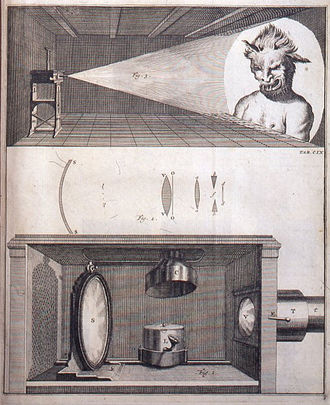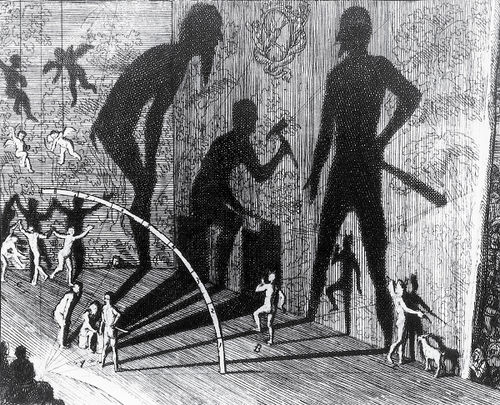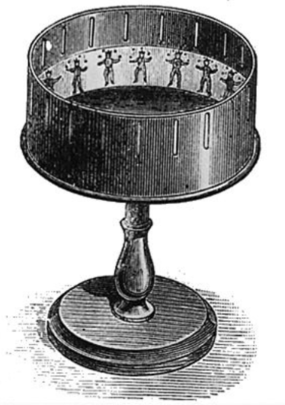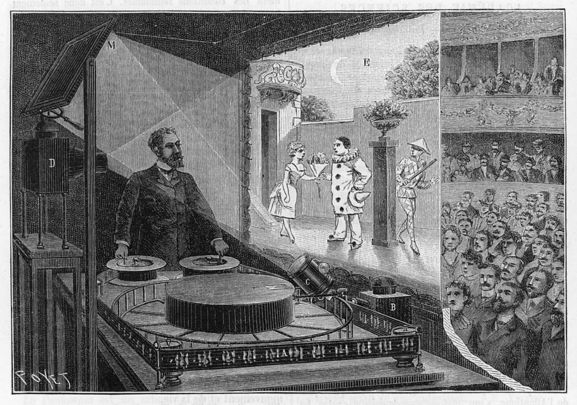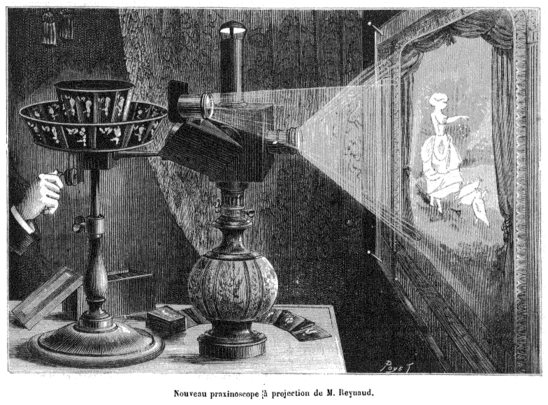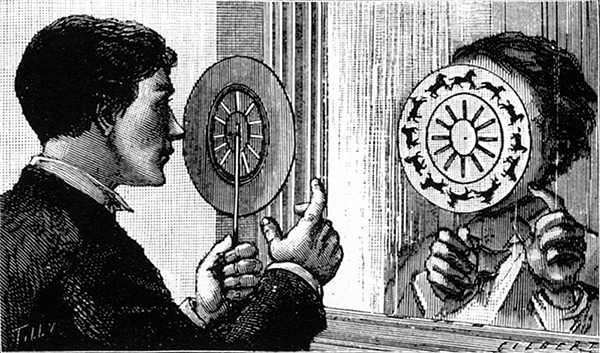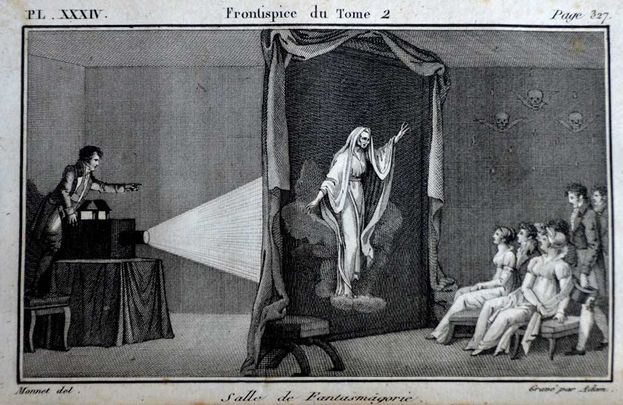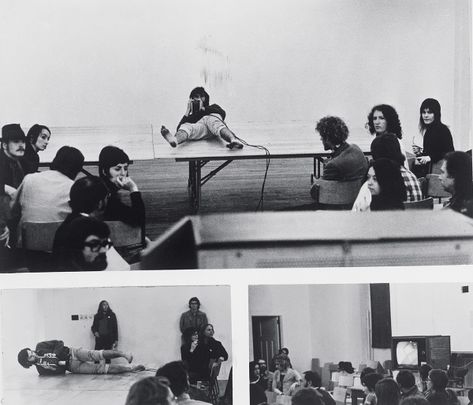User:Zalán Szakács/projectproposal4: Difference between revisions
No edit summary |
No edit summary |
||
| Line 52: | Line 52: | ||
'''Eigengrau''' (project working title) | '''Eigengrau''' (project working title) | ||
<br> | <br> | ||
Coming from German origin, translated into English it means dark light, or brain gray. The term was introduced in 1860 by the German psychologist Gustav Theodor Fechner (1801-1887) to denote the disorganised motion of greyish colour seen in perfect darkness.1 | |||
<br> | <br> | ||
<br> | <br> | ||
| Line 61: | Line 61: | ||
I am fascinated by the epoch of the 18th century, the pre ages of the cinema, where humans created different spatial illusional models through the invention of phantasmagoria, an audio-visual dialogue between the dead and living. (Mannoni, 2000) | I am fascinated by the epoch of the 18th century, the pre ages of the cinema, where humans created different spatial illusional models through the invention of phantasmagoria, an audio-visual dialogue between the dead and living. 1 (Mannoni, 2000) This projection apparatus achieved mobility and moved silently, so the projections appeared in different sizes and movements on the smoke, and opened up the virtual depth of the image space as a sphere of dynamic changes for the first time. 2 (Grau, 2007) | ||
The public was entertained by subjects such as the supernatural, where ghosts and skeletons were the main inspiration sources. Multiple senses were triggered at these events such as vision, audio and tactile. | The public was entertained by subjects such as the supernatural, where ghosts and skeletons were the main inspiration sources. Multiple senses were triggered at these events such as vision, audio and tactile. | ||
| Line 107: | Line 107: | ||
'''Why do you want to make it / Relation to previous practice''' | '''Why do you want to make it / Relation to previous practice''' | ||
I have been VJing since 2012 starting in the underground rave parties of Vienna and moving up to club and festival nights later on. This year I took new steps in my audiovisual practice and was more interested in the conceptual and perceptional approach behind my visuals. How can I play with space, brightness, time and perspective? How can I create an dialogue between the sound and the visual, while only using very minimalistic formal language? | |||
In 2017 at my 360 degree projection mapping performance in La Gaîté Lyrique in Paris I realised, how much impact light has on the audience, if it surrounds them from all the sides and creates an embodied experience. During this summer I performed at two festivals: Dekmantel in Amsterdam and Atlas Electronic in Marrakech. This two underground electronic music festivals had a lot in common, but as well differentiated a lot from each other. My contribution as a visual jockey was to adapt to specific stage setups: Dekmantel festival main stage had an 80 meters long half curved LED wall, and at Atlas Electronic the main stage was an amphitheater with a terracotta wall on which the visuals were projected. Through working as an VJ assistant for the dutch light artist, Arnout Hulskamp at Dekmantel festival I understood the time factor related to space. The animations had to have an impact on the LED wall, but as well for the audience. One clip couldn't just cross the 80 meters in 2 seconds–it needed to be perceived almost in the physical sense. My first encounter of the physical characteristics of the light was at Atlas Electronic festival, where I projected a white cone and through the smoke it created a tunnel between the lens of the projector and the display wall. This discovery lead me to a new fascination of how can I encompass more spatial illusions and dissorientation by only using three main elements such as a dark space, light and smoke. I set this idea into practice during my audiovisual performance in a vault of a bank in Eindhoven, where I projected only vertical and horizontal lines into the space and controlled the right amount of smoke, so suddenly the graphical lines transformed into physical space dividers. To my biggest surprise the audience started to interact with the light beams and wanted to touch them while dancing. During this performance there were moments, when I created total darkness in the space by turning off the projector totally, and at climax moments, when the DJ dropped the beat I turned on on full brightness. The audience experienced different visual stimuli from excitement till anxiety. This made me realise that I would like to explore more the power of light on human perceptions and to understand the contemporary fear. | |||
Since the antiquity humans were fascinated by light and it’s illusionary characteristics, as illustrated by the metaphor of '''Plato’s Cave'''. Around the fifteenth century, perspective and '''camera obscura''' were invented and since then this spatial depiction has become the norm to all other visual representations. Joost Rekveld writes in 2007 the following about these discoveries: 'Perspective was accepted as a ‘scientific’ and true method based on optics, but also as a model of how people could observe space. Gradually people realised that perspective was mostly about a way of looking at reality.' | Since the antiquity humans were fascinated by light and it’s illusionary characteristics, as illustrated by the metaphor of '''Plato’s Cave'''. Around the fifteenth century, perspective and '''camera obscura''' were invented and since then this spatial depiction has become the norm to all other visual representations. Joost Rekveld writes in 2007 the following about these discoveries: 'Perspective was accepted as a ‘scientific’ and true method based on optics, but also as a model of how people could observe space. Gradually people realised that perspective was mostly about a way of looking at reality.' 3 | ||
<br> | <br> | ||
<br> | <br> | ||
| Line 181: | Line 182: | ||
<br> | <br> | ||
1 Hattinger, Gottfried, "Artificial Spaces, Vienna: k/haus, Schlebrügge.Editor,2010. <br> | 1 Hattinger, Gottfried, "Artificial Spaces, Vienna: k/haus, Schlebrügge.Editor,2010. <br> | ||
3 Joost Rekveld 2007, ''Mental Spaces'', viewed 15 October 2018, <http://www.joostrekveld.net/wp/?page_id=590><br> | |||
3 Joost Rekveld 2007 '' Mental Spaces'', viewed 15 October 2018, <http://www.joostrekveld.net/wp/?page_id=590><br> | 3 Joost Rekveld 2007 '' Mental Spaces'', viewed 15 October 2018, <http://www.joostrekveld.net/wp/?page_id=590><br> | ||
4 Steps to an Ecology of Communication: Radical Software, Dan Graham, and the Legacy of Gregory Bateson; William Kaizen: Art Journal, Vol. 67, No. 3 (FALL 2008) | 4 Steps to an Ecology of Communication: Radical Software, Dan Graham, and the Legacy of Gregory Bateson; William Kaizen: Art Journal, Vol. 67, No. 3 (FALL 2008) | ||
5 Steps to an Ecology of Communication: Radical Software, Dan Graham, and the Legacy of Gregory Bateson; William Kaizen: Art Journal, Vol. 67, No. 3 (FALL 2008) | 5 Steps to an Ecology of Communication: Radical Software, Dan Graham, and the Legacy of Gregory Bateson; William Kaizen: Art Journal, Vol. 67, No. 3 (FALL 2008) | ||
Revision as of 16:06, 13 November 2018
Graduation Project Proposal Draft 4
13 | 11 | 18
Eigengrau (project working title)
Coming from German origin, translated into English it means dark light, or brain gray. The term was introduced in 1860 by the German psychologist Gustav Theodor Fechner (1801-1887) to denote the disorganised motion of greyish colour seen in perfect darkness.1
What do you want to make?
I am fascinated by the epoch of the 18th century, the pre ages of the cinema, where humans created different spatial illusional models through the invention of phantasmagoria, an audio-visual dialogue between the dead and living. 1 (Mannoni, 2000) This projection apparatus achieved mobility and moved silently, so the projections appeared in different sizes and movements on the smoke, and opened up the virtual depth of the image space as a sphere of dynamic changes for the first time. 2 (Grau, 2007)
The public was entertained by subjects such as the supernatural, where ghosts and skeletons were the main inspiration sources. Multiple senses were triggered at these events such as vision, audio and tactile.
My goal is to reinterpret this media object into our contemporary context by using new technological developments and searching for the answer for the following question: What constitutes the supernatural of our society? Therefor I would like to explore the integration of new media and technologies in spiritualist contexts.
For Eigengrau, an audiovisual installation designed which immerses the viewer in an uncanny experience – a multi-sensory abstracted space, that embraces our feelings of anxiety and changes our perceptions through space, light, haze and audio. Goal is to unter take weekly experiences with different LED strips, where different characteristics of light will be analysed such as speed, luminance, color, motion, rhythm, structure and vibration. These tests would help me to formulate my answers to my main question, which would create a good foundation for the final light installation.
How does this work differentiates itself from other light installations?
- by it's critical view on interaction and the use of technology
- the way of the interaction
- the audience becomes the performer
- interplay of the surfaces (left and right LED part) creating a unique spatial composition
- by its simplicity
How do you plan to make it?
Firstly I am investigating into two research ways:
- Literature for the thesis (research consists of books and articles around media archaeology, philosophy, psychology light, brain, emotions, space, human perception and technology)
- Prototyping for the graduation project (artistic, hardware and software, Arduino, LED)
What is your timetable?
September – October 2018: Research + Prototyping
November – December 2018: Prototyping & human testing with sensors, some parts are in 1:1 scale
January – February 2019: Finalisation of the installation parts: technical drawing, final software
March – April 2019: Production of the final installation
May 2019: Testing and documenting the process
June 2019: Buffer time
July 2019: Graduation Show
Why do you want to make it / Relation to previous practice
I have been VJing since 2012 starting in the underground rave parties of Vienna and moving up to club and festival nights later on. This year I took new steps in my audiovisual practice and was more interested in the conceptual and perceptional approach behind my visuals. How can I play with space, brightness, time and perspective? How can I create an dialogue between the sound and the visual, while only using very minimalistic formal language? In 2017 at my 360 degree projection mapping performance in La Gaîté Lyrique in Paris I realised, how much impact light has on the audience, if it surrounds them from all the sides and creates an embodied experience. During this summer I performed at two festivals: Dekmantel in Amsterdam and Atlas Electronic in Marrakech. This two underground electronic music festivals had a lot in common, but as well differentiated a lot from each other. My contribution as a visual jockey was to adapt to specific stage setups: Dekmantel festival main stage had an 80 meters long half curved LED wall, and at Atlas Electronic the main stage was an amphitheater with a terracotta wall on which the visuals were projected. Through working as an VJ assistant for the dutch light artist, Arnout Hulskamp at Dekmantel festival I understood the time factor related to space. The animations had to have an impact on the LED wall, but as well for the audience. One clip couldn't just cross the 80 meters in 2 seconds–it needed to be perceived almost in the physical sense. My first encounter of the physical characteristics of the light was at Atlas Electronic festival, where I projected a white cone and through the smoke it created a tunnel between the lens of the projector and the display wall. This discovery lead me to a new fascination of how can I encompass more spatial illusions and dissorientation by only using three main elements such as a dark space, light and smoke. I set this idea into practice during my audiovisual performance in a vault of a bank in Eindhoven, where I projected only vertical and horizontal lines into the space and controlled the right amount of smoke, so suddenly the graphical lines transformed into physical space dividers. To my biggest surprise the audience started to interact with the light beams and wanted to touch them while dancing. During this performance there were moments, when I created total darkness in the space by turning off the projector totally, and at climax moments, when the DJ dropped the beat I turned on on full brightness. The audience experienced different visual stimuli from excitement till anxiety. This made me realise that I would like to explore more the power of light on human perceptions and to understand the contemporary fear.
Since the antiquity humans were fascinated by light and it’s illusionary characteristics, as illustrated by the metaphor of Plato’s Cave. Around the fifteenth century, perspective and camera obscura were invented and since then this spatial depiction has become the norm to all other visual representations. Joost Rekveld writes in 2007 the following about these discoveries: 'Perspective was accepted as a ‘scientific’ and true method based on optics, but also as a model of how people could observe space. Gradually people realised that perspective was mostly about a way of looking at reality.' 3
Towards the end of nineteenth century non-euclidian geometry was discovered by mathematicians such as Friedrich Gauss, Nikolai Ivanovich Lobachevsky, Janos Bolyai and this brought up the concept of the fourth dimension, the concept of time in relationship with space.
Movement and light became an important motivation for the artists and designers from Bauhaus such as Laszlo Moholy-Nagy.
The digital developments of the twentieth century brought mankind new spatial perception such as Cyberspace. 'This space appears to be real and at the same time not geometric or not real in any physically determined way. We use completely new concepts to visualise or understand this space: rhizomes, networks consisting of nodes without any hierarchy, etc.' 3 (Rekveld, 2007)
In 1970 the Artist Dan Graham coined the term “cyberspace” by this he meant a space which is meditated through the feedback technology of video tape; It was Graham who –11 years before William Gibson used it – coined the term “cyberspace” to describe the new inter-subjective technological space created by the interaction of humans within a video mediated circuit” 4 (William Kaizer, 2008)
Bateson's media ecology puts on display the ways in which formats limit communication, exposing how the techno-social context of communica- tion is as relevant as any content. In a similar way, in 1964 Marshall McLuhan announced that "the medium is the message." But if McLuhan takes technologi- cal formats to be "extensions of man," Bateson goes further. He gives up any notion of man, redefining the self as an expanded mental field in which the sub- ject and its objects are no longer separable. For Bateson, "mind" is no longer bounded by the individual body, becoming a conjunction of self and world produced through communicative ecologies. 5 (William Kaizer, 2008)
After the millenium humans desired new understandings of spatial concepts as called ‘post-digital spaces’. These are psychical spaces build by digital components such as custom made software, sensors, digital interaction, where the digital merges with the physical, creating a hybrid environment. Human senses are triggered by these elements, while creating new sensory experiences, which have been deeply researched and experimented by scientist and artist in 1960’s such as James Turrell in his Ganzfeld Effect spaces.
Our everyday life is deeply interwoven with screens and interfaces therefor there is a tendency and desire to break out of them.
Who can help you and how?
PZI staff: Javier Lloret (LED), Steve Rushton (Theory)
Children of the Light: Arnout Hulskamp, Christopher Gabriel (LED)
Sound:frame: Eva Fischer (Theory)
Relation to a larger context
roiji ikeda
james turrel
nonotak
joris strijbos
uva
strp biennale
atonal berlin
mutek montreal
ctm festival
todaysart
china light festival
ars electronica
sonic acts
algorave
live coding culture
algorithms from nature
References
Reading
Sources
1 Hattinger, Gottfried, "Artificial Spaces, Vienna: k/haus, Schlebrügge.Editor,2010.
3 Joost Rekveld 2007, Mental Spaces, viewed 15 October 2018, <http://www.joostrekveld.net/wp/?page_id=590>
3 Joost Rekveld 2007 Mental Spaces, viewed 15 October 2018, <http://www.joostrekveld.net/wp/?page_id=590>
4 Steps to an Ecology of Communication: Radical Software, Dan Graham, and the Legacy of Gregory Bateson; William Kaizen: Art Journal, Vol. 67, No. 3 (FALL 2008)
5 Steps to an Ecology of Communication: Radical Software, Dan Graham, and the Legacy of Gregory Bateson; William Kaizen: Art Journal, Vol. 67, No. 3 (FALL 2008)

